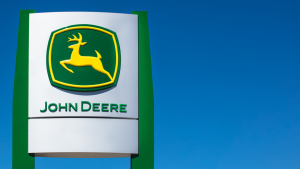- Russia’s invasion of Ukraine has sparked interest in agriculture stocks.
- Archer-Daniels-Midland (ADM): Archer-Daniels-Midland is the largest publicly traded farmland product company in the U.S.
- Deere (DE): Deere is a top name in the manufacturing of farm equipment.
- Scotts Miracle-Gro (SMG) : A leading provider of consumer lawn and garden products, Scotts Miracle-Gro offers many household names.
Russia’s invasion of Ukraine has sparked interest in agriculture stocks after the conflict triggered substantial increases in commodity prices since it began several months ago.
Ukraine is one of the leading exporters of corn, sunflower oil and wheat. Grain exports used to total nearly 5 million tons per month for the country, but now exports sit at close to just 500,000 tons per month.
As a result, food prices are likely to remain high for at least as long as the war continues.
In addition, the United Nations reports that the world will need to produce 60% more food to feed an estimated 9.3 billion people by 2050.
Near record highs for global food products in the short term coupled with the need for aggressive food production in the long term will likely mean strong results for companies operating in the agricultural space.
Here are three of our favorite agricultural stocks.
| Ticker | Company | Price |
| ADM | Archer-Daniels-Midland | $91.41 |
| DE | Deere | $388.50 |
| SMG | Scotts Miracle-Gro | $103.75 |
Archer-Daniels-Midland (ADM)

Our first pick among agricultural stocks is Archer-Daniels-Midland (NYSE:ADM), the largest publicly traded farmland product company in the U.S. The $53 billion company has generated revenue of more than $85 billion last year.
Thanks to its size, Archer-Daniels-Midland benefits from economies of size and scale. The company had approximately 450 crop procurement locations, 320 food and feed processing facilities, and more than 60 innovation centers. The company also has a significant presence in international markets due to its global distribution system. There are few, if any, companies that can match Archer-Daniels-Midland’s infrastructure both domestically and internationally.
Archer-Daniels-Midland has four segments, including carbohydrate solutions, nutrition, origination, and oilseeds. The company produces a vast variety of products and services used in the agricultural industry, which will be needed to meet the ever-growing demand for food production to feed increases in population.
And with a large product portfolio, the company can act as a one-stop-shop for customers seeking to fill their needs. These factors should allow the company to be well-positioned to see growth not just in the short-term, but also the long-term as world population’s need for food increases.
Archer-Daniels-Midland’s business model has proven to be very recession proof as food demand often remains consistent during economic downturns. The company saw earnings-per-share grow almost 29% from 2007 to 2009. More recently, Archer-Daniels-Midland weathered the worst of the Covid-19 pandemic extremely well as bottom-line results improved 29% from 2019 to 2020.
This ability to grow in recessions is a major reason why Archer-Daniels-Midland has raised its dividend for 47 years, qualifying the company as a Dividend Aristocrat and placing it just three years away from attaining Dividend King status. It is likely that Archer-Daniels-Midland’s dividend growth streak continues as the expected payout ratio for 2022 is just 31%. Shares of the company yield 1.7%, slightly above the average yield of 1.5% for the S&P 500.
Deere (DE)

Next up is Deere & Company (NYSE:DE), a top name in the manufacturing of farm equipment. The company has a market capitalization of $119 billion and has produced revenue of $44.5 billion over the last twelve-months.
Deere is the largest farm equipment manufacturer in the world, which provides it advantages over its smaller competitors due to the sheer size and reach of its business. The company also produces equipment used by customers in such areas such as construction and forestry and turf care.
Deere’s size prevents would be competitors from taking market share from the company as its global network of dealers is financially difficult to copy. This also helps the company secure top pricing as it doesn’t have to discount its products in order to capture market share.
Deere has taken steps to augment its business with strategic acquisitions. Sometimes acquisitions are more of the smaller, bolt-on type, such as the company’s $305 million purchase of Blue River Technology in 2017 that added robotic herbicide sprayers to the product portfolio.
Other times, Deere makes larger purchases to improve its standing in an area it doesn’t have much of a presence. A good example of this is the company’s $5.2 billion addition of Wirtgen Group, which manufactures road construction equipment. Prior to this deal, Deere did not produce road building equipment, such as pavers, but now is an industry leader in such equipment.
Unlike Archer-Daniels-Midland, Deere is much more of a cyclical company. Customers tend to make new investment in machinery when their businesses are seeing growth. When times are more challenging, they put off making massive outlays of capital. As a result, earnings-per-share were cut in half during the last recession. Then Covid-19, and the resulting shutdown of large parts of the global economy, caused a 14% decrease in earnings-per-share in 2020.
The good news is that while Deere is susceptible to downturns in the economy, demand for its products in periods of growth is substantial. The company experienced sharp rebounds in its business immediately after these difficult periods. Earnings-per-share grew 111% in fiscal year 2010 and surged almost 119% last fiscal year.
Deere has paused its dividend several times over the long term, including from 2015 to 2017 and from 2019 to 2020. These were likely prudent decisions as the company dealt with some uncertainty in its business. Investors will note that the company hasn’t cut its dividend during this time. We expect that Deere will continue to grow its dividend going forward as the projected payout ratio for this year is just 19%. Deere yields 1.1% currently.
Scotts Miracle-Gro (SMG)

Our final agricultural name for consideration is Scotts Miracle-Gro Company (NYSE:SMG), a leading provider of consumer lawn and garden products. The company is valued at nearly $6 billion and generates close to $5 billion of annual sales.
Scotts Miracle-Gro’s portfolio contains several household names, including the namesakes Scotts and Miracle-Gro. The company is the most recognizable name in lawn and garden care in the U.S.
Having well-known and trusted brands gives Scotts Miracle-Gro a leg up on the competition. Home improvement stores, both national and local, favor the company’s products as they can help drive store traffic. Brand recognition and prime shelf space affords the company the ability to charge premium prices compared to its competitors without negatively impacting its market share. Scotts Miracle-Gro is the rare company that can increases its product pricing while also improving its standing in its industry.
Scotts Miracle-Gro has a growing hydroponics business as well. Currently just a 25% contributor to sales, this area should become more important as the need for indoor and year-round food production increases along with food demand.
The company struggled during the Great Recession as earnings-per-share turned negative in 2008. Scotts Miracle-Gro did rebound to record a new high for earnings-per-share the very next year. During 2020, bottom-line results declined 7%, before establishing another new high in 2021.
Scotts Miracle-Gro has raised its dividend for the past 12 years. We believe that the company will continue to provide future dividend growth as well as the payout ratio is expected to be 31% this year. Shares of the company yield 2.6%, nearly twice the average yield of the S&P 500 Index.
Final Thoughts
The ongoing war in Ukraine has caused commodity prices to hit fresh highs in recent months. Looking out further, food production is going to need to ramp up in order to meet growing demand over the next three decades.
With both short-term and long-term tailwinds, the agricultural industry should be one of the higher growth areas in the market place. This likely means higher dividend yields as well.
Archer-Daniels-Midland, Deere and Scotts Miracle-Gro have competitive advantages over its peer group, making each the best-of-breed in its respective industry. Investors looking to profit from growing demand for agricultural products, we suggest they consider one of these stocks for their portfolio.
On the date of publication, Bob Ciura did not have (either directly or indirectly) positions in any of the securities mentioned in this article. The opinions expressed in this article are those of the writer, subject to the InvestorPlace.com Publishing Guidelines.
